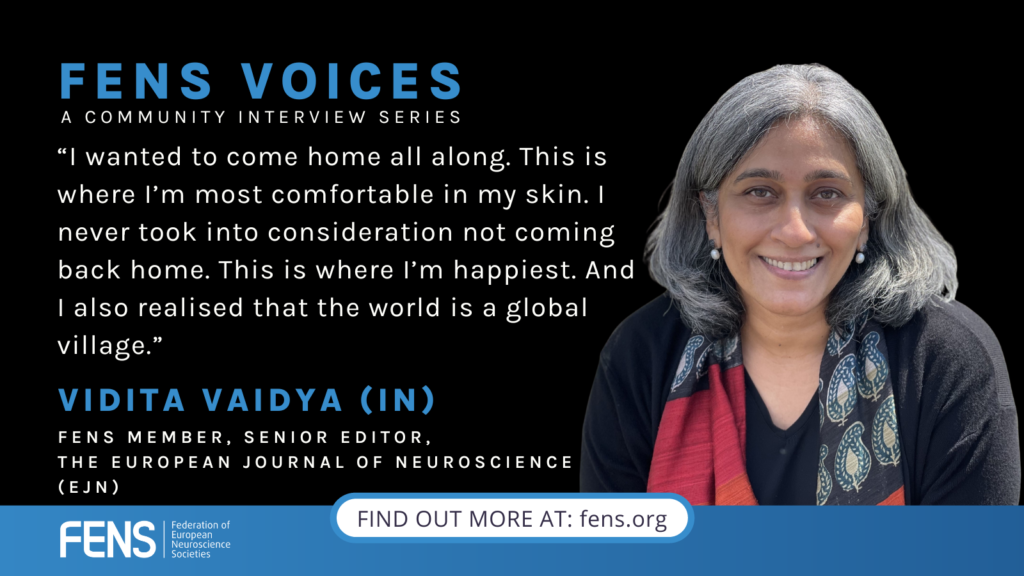
FENS Voices | Vidita Vaidya: Longing for home
09 June 2023
FENS News, Neuroscience News
FENS recently talked to Dr Vidita Vaidya about her role as a Senior Editor for the European Journal of Neuroscience (EJN), the official journal of FENS. Her research group is interested in understanding the neurocircuitry of emotion, its modulation by life experience and by psychoactive compounds, in particular serotonergic psychedelics. She received the National Bioscientist Award from the Government of India in 2012, the Shanti Swarup Bhatnagar Prize in Medical Sciences in 2015, the Nature Award for Mentorship from India in the mid-career category in 2019, and the Infosys Prize in Life-Sciences in 2022. She is committed to working to enhance equity and inclusion in academic spaces, and is passionate about science communication and outreach. Read the full interview below.
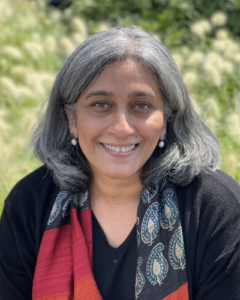
Both of your parents, Dr Rama Vaidya and Dr Ashok Vaidya, are scientists. How much did your family’s background motivate you to develop a career in research? What did you want to be when you grew up?
VV: Indeed, they are clinician scientists. They both are M.D-PhDs. Nonetheless, growing up I wanted to be an archaeologist. I am not sure why, but I thought that was the coolest thing in the world. I mean, when I think about it, I don’t know what exactly amazed me, but I really liked the idea that you went digging in places and could find out how people thousands of years ago might have lived. So as a kid, I had these books on archaeology that I read. But then I realised that it is actually a lot of hard work. You have to sit in the middle of some really hot and humid places for hours with immense patience. And it’s not like you will discover a whole city and a whole new civilisation. Most of it is finding just small pieces and fragments of things. But as a child, I was fascinated by archaeology and that was the earliest thing I sort of thought was so interesting. In my household, my grandfather was a freedom-fighter and a novelist. My granduncle was a poet and my grandaunt was a feminist writer, one of the few early feminist writers of India. So, there was literature on the one hand and then there was science and medicine on the other. These were the two elements at home, and both seemed equally interesting in a sense. I think I sort of knew I wanted to do something broadly in the space of behaviour when I was about 14. I knew I kind of liked biology, but I hadn’t figured out that I wanted to be a scientist. I just thought studying behaviour was really interesting and I liked the idea that people could study animal behaviour in the wild. That was a time and era where we didn’t have television, but I did watch BBC videos and shows sometimes. I watched a film on Dian Fossey and one on Jane Goodall, and I couldn’t believe that there were these incredible women who were studying animal behaviour in the wild. I was very impressed and blown away by that possibility as a teenager. I knew I didn’t want to study medicine, but the notion that people could observe animals in their natural habitats, and study behaviour was very fascinating. That was my early inspiration.
What made you want to pursue a PhD in Neuroscience and what was the topic of your thesis?
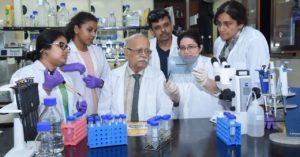 VV: I always knew I wanted to do neuroscience and behaviour in some way. I also had these very romantic ideas about the fact that I would go out and study animals in the wild, and then I realised the actual hardships of doing it. One of my favourite books is “A Primate’s Memoir: A Neuroscientist’s Unconventional Life Among the Baboons” by Robert M. Sapolsky, and he’s one of the scientists I deeply admire. He talks about how he was sitting and studying baboons in the wild in the 1980s. It is a fascinating book, but it also tells you how hard this research actually is. It’s not easy to study animals in their natural environment. I think my very grandiose plans shrunk to the awareness that I would be quite happy studying animal behaviour using rodents in the context of a lab setting, because that was far more manageable. I knew I wanted to do something neuroscience-related in my second or third year of my undergrad, but as I had no training or experience, I just took a leap of faith by saying I think I love this, I love reading about it. I hoped I would get into a good graduate program and I would find out that I really liked the field after actually doing some research at the bench.
VV: I always knew I wanted to do neuroscience and behaviour in some way. I also had these very romantic ideas about the fact that I would go out and study animals in the wild, and then I realised the actual hardships of doing it. One of my favourite books is “A Primate’s Memoir: A Neuroscientist’s Unconventional Life Among the Baboons” by Robert M. Sapolsky, and he’s one of the scientists I deeply admire. He talks about how he was sitting and studying baboons in the wild in the 1980s. It is a fascinating book, but it also tells you how hard this research actually is. It’s not easy to study animals in their natural environment. I think my very grandiose plans shrunk to the awareness that I would be quite happy studying animal behaviour using rodents in the context of a lab setting, because that was far more manageable. I knew I wanted to do something neuroscience-related in my second or third year of my undergrad, but as I had no training or experience, I just took a leap of faith by saying I think I love this, I love reading about it. I hoped I would get into a good graduate program and I would find out that I really liked the field after actually doing some research at the bench.
Your postdoctoral research was done at the Karolinska Institute (SE) and at the University of Oxford (UK), and then you returned to India where you became a PI at the Tata Institute of Fundamental Research, in Mumbai. Why did you choose to return and did you detect any differences in the way in which neuroscience research was conducted across the countries in which you worked?
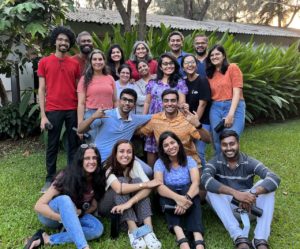 VV: I wanted to come home all along. This is where I’m most comfortable in my skin, as this is my home. I never took into consideration not coming back home. I could see the advantages of doing research in places like Yale, Karolinska and Oxford, and I knew it would be a ton easier to continue in those systems because I wouldn’t have to build anything from scratch, but I just wanted to return. This is my space: I grew up in this city, in this country. I would not trade my own space for any other. This is where I’m happiest. And I also realised that the world is a global village. I can always travel for conferences and keep going back, collaborating with colleagues. I didn’t spend too much time thinking about the alternative. I just decided to come home. It was a leap of faith, which is what I think I needed to do because if I thought about it for too long, I would have then thought of how hard it would be to set up a lab and all the challenges that followed. And then I would have had to think: “how will I manage?”
VV: I wanted to come home all along. This is where I’m most comfortable in my skin, as this is my home. I never took into consideration not coming back home. I could see the advantages of doing research in places like Yale, Karolinska and Oxford, and I knew it would be a ton easier to continue in those systems because I wouldn’t have to build anything from scratch, but I just wanted to return. This is my space: I grew up in this city, in this country. I would not trade my own space for any other. This is where I’m happiest. And I also realised that the world is a global village. I can always travel for conferences and keep going back, collaborating with colleagues. I didn’t spend too much time thinking about the alternative. I just decided to come home. It was a leap of faith, which is what I think I needed to do because if I thought about it for too long, I would have then thought of how hard it would be to set up a lab and all the challenges that followed. And then I would have had to think: “how will I manage?”
Your current lab focuses on the neurocircuitry of emotion, studying the molecular, epigenetic and cellular changes that contribute to persistent alterations in behaviour, aiming to understand complex psychiatric disorders. What is the unique niche you occupy?
VV: This question becomes especially important when you’re sitting across the world in India, where the ecosystem is still nascent. You don’t have too many people in the local community doing this kind of work. We decided that we would look at the effects of early life stress across the lifespan rather than just looking at them largely in young adulthood. Most groups around the world using rodent models have looked at many different models of early adversity, but have restricted their research to time points when these animals become young adults. We discovered over the last ten years that analysing models for a longer duration of time is very important, as the effects of early life stress are not invariant. What we actually found was that early stress may actually evoke adaptive changes in young adulthood and maladaptive effects in middle-aged life. This is something we are really interested in because it tells us that there is a large window after early adversity, where you could still potentially intervene and prevent the longer-term consequences that are going to come once these animals hit middle-aged life.
In 2020, you joined the editorial board of The European Journal of Neuroscience (EJN) as a Senior Editor. Why did you decide to join EJN?
VV: Well, my first paper ever as an independent PI was published in the European Journal of Neuroscience as a short communication. While the European Journal of Neuroscience represents FENS in principle just like The Journal of Neuroscience does represent the Society for Neuroscience, these societies attract people from all around the world. Nonetheless, you don’t really see a strong Asian representation yet in their editorial boards. And this would be important because you will see significant growth in basic science emerging from both India and China in the next several decades. Not having that representation is just like missing a large chunk of the world. So I was happy to be asked to join the editorial board and it has been a wonderful experience. I’ve thoroughly enjoyed working with the EJN team, alongside other senior editors and our editor in chief, John Foxe.
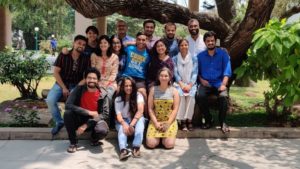 Why is it important to support society journals, such as EJN?
Why is it important to support society journals, such as EJN?
VV: Society journals are meant to be supported by the scientific community, and offer support in return, as these are run by and for scientists. These are peer-reviewed by a scientific community. I think we should not outsource our entire scientific output to the juggernaut of the publishing industry. I’m a big fan of society journals, I’ve always admired them. I hope to see every researcher view society journals as the place they would consider submitting their work to, and when that reach is genuinely global then the job will have been well done.
Why is publishing in EJN important for neuroscientists outside of the European space?
VV: John Cryan once told me something quite interesting. He said: “You know, when you move away from what are the hotspots where science happens, relatively the rest of the world seems to be like an outpost.” One hotspot is North America, and another hotspot is represented by certain areas of Europe. These places contain a large number of scientists, working in big teams. So if you need to start thinking about scientific spaces as genuinely global, you need to reimagine editorial boards, societies, and so on. While they do serve their purposes locally, they also have to widen. FENS has opened, and attempted to do that. But there’s more to be done, because science is not restricted by national boundaries.
On the one hand, I’m telling you that I wanted to come back to my country and do science in India, but, you know, in principle, science is eventually a human endeavour. It shouldn’t really matter where you practice your science and yet unfortunately location matters.
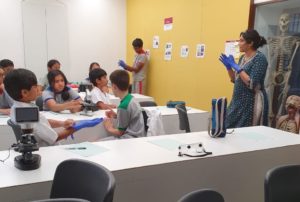 Why are equity and diversity so important in the context of scientific research?
Why are equity and diversity so important in the context of scientific research?
VV: Science is not as well represented in the developing world or the low-medium income group of countries and this has far-reaching consequences. We witnessed some of this during the pandemic where inequities were deeply steepened. I was very privileged to have received my doctoral and postdoctoral training abroad, and so that gives me a certain familiarity with these scientific ecosystems. But I am well aware that plenty of people who trained in the Indian scientific ecosystem or elsewhere in LMICs, sometimes can feel alienated by the absence of diversity on editorial boards, in scientific societies, in conference speaker lists etc. And I think it is vital to work toward equity and diversity in these spaces.
About the European Journal of Neuroscience (EJN)
The European Journal of Neuroscience (EJN) is the official journal of FENS. Edited by Prof. John Foxe from the University of Rochester (USA) together with four Senior Editors Antoine Adamandis (CH), Paola Bovolenta (ES), Yoland Smith (USA), Vidita Vaidya (IN), EJN publishes original high-quality research articles and reviews in all domains of neuroscience. See the full Editorial Board on the EJN website.
EJN embraces Open Science, offers a rapid and easy submission process, fair and transparent peer review, no submission fees, page charges or formatting requirements, and ensures visibility with close to a million downloads per year (many being cited years after publication). EJN also serves fellow researchers by helping to support FENS activities and awards such as the FENS EJN Award, FENS EJN Young Investigator Prize and EJN Best Publication Award.
About the Federation of European Neuroscience Societies (FENS)
Founded in 1998, the Federation of European Neuroscience Societies is the main organisation for neuroscience in Europe. It currently represents 44 national and single-discipline neuroscience societies across 33 European countries and more than 22,000 member scientists. Discover FENS and subscribe to our biweekly News Alert, with information on our latest calls and activities.